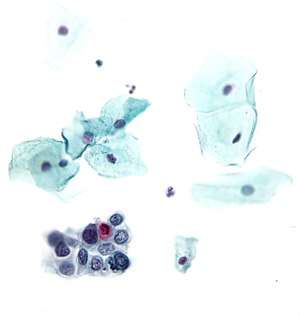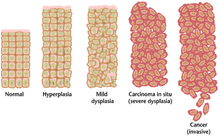Precancerous condition
A precancerous condition is a condition or lesion involving abnormal cells which are associated with an increased risk of developing into cancer.[1][2][3] Clinically, precancerous conditions encompass a variety of conditions or lesions with an increased risk of developing into cancer. Some of the most common precancerous conditions include certain colon polyps, which can progress into colon cancer, monoclonal gammopathy of undetermined significance, which can progress into multiple myeloma or myelodysplastic syndrome.[4] and cervical dysplasia, which can progress into cervical cancer.[5] Pathologically, precancerous lesions can range from benign neoplasias, which are tumors which do not invade neighboring normal tissues or spread to distant organs, to dysplasia,[1] which involves collections of abnormal cells which in some cases have an increased risk of progressing to anaplasia and invasive cancer. Sometimes the term "precancer" is also used for carcinoma in situ, which is a noninvasive cancer that has not progressed to an aggressive, invasive stage. As with other precancerous conditions, not all carcinoma in situ will progress to invasive disease.
| Precancerous condition | |
|---|---|
| Other names | Premalignant condition, precancer, premalignancy, dysplasia, intraepithelial neoplasm, carcinoma in situ |
 | |
| Micrograph of high grade squamous intraepithelial lesion, a precancerous condition of the uterine cervix. Pap stain. | |
| Specialty | Oncology |
Classification
The term precancerous or premalignant condition may refer to certain conditions, such as monoclonal gammopathy of unknown significance, or to certain lesions, such as colorectal adenoma (colon polyps), which have the potential to progress into cancer (see: Malignant transformation). Premalignant lesions are morphologically atypical tissue which appear abnormal when viewed under the microscope, and which are more likely to progress to cancer than normal tissue.[6] Precancerous conditions and lesions affect a variety of organ systems, including the skin, oral cavity, stomach, colon, and hematological system. Some authorities also refer to hereditary genetic conditions which predispose to developing cancer, such as hereditary nonpolyposis colorectal cancer, as a precancerous condition, as individuals with these conditions have a much higher risk of developing cancer in certain organs.[3]
Signs and symptoms
The signs and symptoms of precancerous conditions differ based on the organ affected. In many cases, individuals with precancerous conditions do not experience any symptoms. Precancerous conditions of the skin or oral cavity often appear as visible lesions without associated pain or discomfort,[6] while precancerous conditions of the hematological system are typically asymptomatic, or in the case of monoclonal gammopathy of unknown significance, may rarely cause numbness and tingling in the hands and feet or difficulty with balance[7] (see: peripheral neuropathy).
Causes
In many cases, risk factors for precancerous conditions and lesions are the same risk factors that predispose individuals to a specific cancer. For example, individuals with cervical or anal infection with oncogenic, or cancer causing, strains of human papilloma virus (HPV) are at elevated risk for cervical and anal cancers,[8] respectively, as well as for cervical and anal dysplasia.[8] Similarly, sun exposure is an important risk factor for both actinic keratosis[9] as well as skin cancer. However, in many cases, precancerous conditions or lesions can be sporadic and idiopathic in nature, meaning that they are not associated with a hereditary genetic predisposition to the particular cancer, nor with a direct causative agent or other identifiable cause.[10]
Pathophysiology

The pathophysiology of precancerous lesions is thought to be similar to that of cancer, and varies depending on the disease site and type of lesion.[11] It is thought that cancer is preceded by a clinically silent premalignant phase during which oncogenic genetic and epigenetic alterations accumulate. The duration of this premalignant phase can vary from cancer to cancer and from individual to individual.[10]
Examples
Skin
Breast
- ductal carcinoma in situ
- Sclerosing adenosis
- Small duct papilloma
Head and neck/oral
Gastrointestinal
Gynecological
Urological
Hematological
References
- "NCI Dictionary of Cancer Terms". National Cancer Institute. 2011-02-02. Retrieved 2018-03-28.
- "Precancerous conditions of the colon or rectum". Canadian cancer society. Retrieved 2018-03-19.
- "Precancerous conditions of the esophagus". Canadian cancer society. Retrieved 2018-03-19.
- Korde N, Kristinsson SY, Landgren O (May 2011). "Monoclonal gammopathy of undetermined significance (MGUS) and smoldering multiple myeloma (SMM): novel biological insights and development of early treatment strategies". Blood. 117 (21): 5573–81. doi:10.1182/blood-2011-01-270140. PMC 3316455. PMID 21441462.
- "Precancerous conditions of the cervix". Canadian cancer society. Retrieved 2018-03-19.
- Yardimci G, Kutlubay Z, Engin B, Tuzun Y (December 2014). "Precancerous lesions of oral mucosa". World Journal of Clinical Cases. 2 (12): 866–72. doi:10.12998/wjcc.v2.i12.866. PMC 4266835. PMID 25516862.
- "MGUS - MGUS Multiple Myeloma - MGUS Myeloma -Monoclonal Gammopathy". Multiple Myeloma Research Foundation. Retrieved 2018-03-28.
- Roberts JR, Siekas LL, Kaz AM (February 2017). "Anal intraepithelial neoplasia: A review of diagnosis and management". World Journal of Gastrointestinal Oncology. 9 (2): 50–61. doi:10.4251/wjgo.v9.i2.50. PMC 5314201. PMID 28255426.
- "Actinic keratosis - Symptoms and causes". Mayo Clinic. Retrieved 2018-03-28.
- Willimsky G, Czéh M, Loddenkemper C, Gellermann J, Schmidt K, Wust P, Stein H, Blankenstein T (July 2008). "Immunogenicity of premalignant lesions is the primary cause of general cytotoxic T lymphocyte unresponsiveness". The Journal of Experimental Medicine. 205 (7): 1687–700. doi:10.1084/jem.20072016. PMC 2442645. PMID 18573907.
- Hyndman IJ (April 2016). "Review: the Contribution of both Nature and Nurture to Carcinogenesis and Progression in Solid Tumours". Cancer Microenvironment. 9 (1): 63–9. doi:10.1007/s12307-016-0183-4. PMC 4842185. PMID 27066794.
- "Actinic Keratosis". skincancer.org. Retrieved 2018-03-19.
- Neville BW, Day TA (July 2002). "Oral cancer and precancerous lesions". Ca. 52 (4): 195–215. doi:10.3322/canjclin.52.4.195. PMID 12139232.
- "What Is Vaginal Cancer?". www.cancer.org. Retrieved 2018-03-28.
- Arya M, Kalsi J, Kelly J, Muneer A (March 2013). "Malignant and premalignant lesions of the penis". BMJ. 346: f1149. doi:10.1136/bmj.f1149. PMID 23468288.
- "Bladder Cancer Staging | Bladder Cancer Stages". www.cancer.org. Retrieved 2018-03-28.
External links
| Classification |
|
|---|
| Look up premalignant or precancerous in Wiktionary, the free dictionary. |